biopsychology
What is the function of the endocrine system?
Allow communication between parts of the body through hormones.
Define hormones
Chemicals secreted by glands into the bloodstream to stimulate cells in another part of the body.
1/241
There's no tags or description
Looks like no tags are added yet.
Name | Mastery | Learn | Test | Matching | Spaced |
|---|
No study sessions yet.
242 Terms
What is the function of the endocrine system?
Allow communication between parts of the body through hormones.
Define hormones
Chemicals secreted by glands into the bloodstream to stimulate cells in another part of the body.
Define glands
Organs which secrete hormones into the bloodstream.
What do both the endocrine and nervous systems allow?
Communication between body parts.
What are the differences between the endocrine and nervous systems?
1. In the endocrine system, hormones transmit signals using the bloodstream whereas in the nervous system neurotransmitters transmit signals between neurons.
2. Signals are transmitted much more quickly in the nervous system (in a matter of milliseconds) than the endocrine system.
What are the hypothalamus and pituitary gland?
Two glands in the brain which release numerous hormones which cause other glands around the body to release their own hormones.
What is the pituitary gland referred to as?
master gland
What hormone does the pineal gland secrete?
Melatonin
What is the role of melatonin?
Causes drowsiness encouraging sleep.
What hormone does the adrenal glands secrete?
Adrenaline
What effect does adrenaline have?
Causes fight-or-flight reactions; increased heart and breathing rate and blood flow to the large muscles.
What hormone does the ovaries secrete?
Oestrogen
What effect does oestrogen have?
Triggers puberty in females and regulates the menstrual cycle.
What hormone does the testicles secrete?
Testosterone
What effect does testosterone have?
Triggers puberty in males and is involved in the production of sperm.
What hormone does the pancreas secrete?
Insulin
What effect does insulin have?
Keeps blood sugar levels regular.
Label a diagram of the location of glands
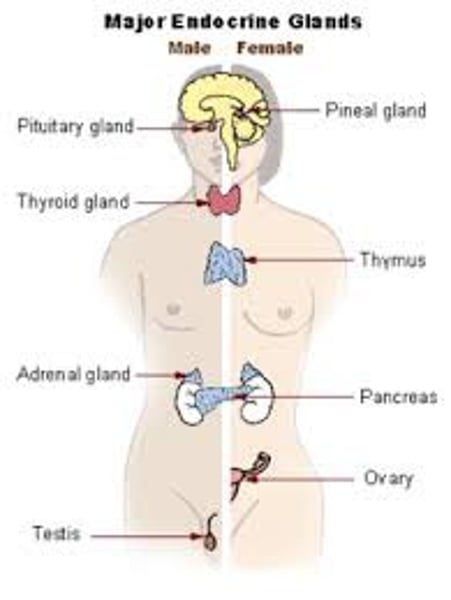
What are neurons specialised for?
Receiving and transmitting electrical and chemical signals.
What is the structure of the nervous system?
All the nervous tissue in the body.
What is the function of the nervous system?
Detects, transmits, interprets and responds to environmental stimuli.
What is the structure of the central nervous system (CNS)?
Brain and spinal cord.
What is the function of the central nervous system (CNS)?
Interpret information from the peripheral nervous system and send signals to the peripheral nervous system to respond.
What is the structure of the peripheral nervous system (PNS)?
All the nerves outside the central nervous system.
What is the function of the peripheral nervous system (PNS)?
Detect environmental stimuli and transmit the information to the central nervous system, and to transmit signals from the CNS to glands, organs and muscles to respond to the environmental stimuli.
What is the structure of the somatic nervous system (SNS)?
Nerves which carry information between the central nervous system and the skeletal muscles (muscles of the arms and legs) and sense organs (eyes, ears, nose, tongue and skin).
What is the function of the somatic nervous system (SNS)?
Transmits sensory information from sense organs to the central nervous system. It also transmits motor commands from the central nervous system to the skeletal muscles to enable voluntary movements.
Which neurons does the SNS contain?
sensory and motor neurons
What is the structure of the autonomic nervous system (ANS)?
Nerves which carry information from the central nervous system to the internal organs (heart, lungs, stomach, intestines, liver, kidneys and bladder)
What is the function of the autonomic nervous system (ANS)?
Transmits commands from the central nervous system to control involuntary functions such as heart rate, breathing rate, digestion, urination, and sexual arousal.
Which type of neurons does the ANS contain?
Only motor neurons.
What does the autonomic nervous system control?
The activity of the internal organs.
Diagram of the divisions of the nervous system
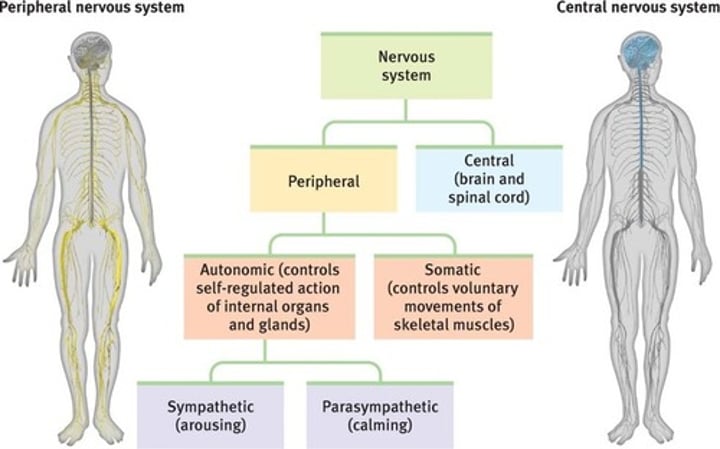
What are the two divisions of the autonomic nervous system?
sympathetic and parasympathetic
When does the sympathetic division become active?
When we feel under threat or become excited.
What does the sympathetic division cause?
A number of changes to the functioning of the body to allow the body to confront or avoid the threat.
What are the changes caused by the activation of the sympathetic division known as?
the 'fight or flight' response
Outline the detection stage in the fight or flight response?
The detection of a stressor in the environment causes an increase in activity in the hypothalamus. This sends a signal to the sympathetic division of the autonomic nervous system and to the adrenal medulla.
What do spinal nerves of the sympathetic division do in the fight or flight response?
The spinal nerves of the sympathetic division send signals to internal organs of the body.
What does the adrenal medulla do in the flight or flight response?
The adrenal medulla releases adrenaline into the bloodstream. Adrenaline binds to receptors throughout the body.
What effects occur to fuel the large muscles in the fight or flight response?
1. An increase in lung capacity
2. An increase in heart rate
3. An increase in blood flow to the skeletal muscles
4. A decrease in blood flow to the skin
5. A decrease in activity in the digestive and immune systems
Give an example of the nervous and endocrine systems working together
The fight or flight response
How did the fight or flight response evolve?
To be activated rapidly but very rarely when an organism or its family were under threat.
What division of the fight or flight response should be activated most of the time? Why?
The parasympathetic division should be activated allowing the body to rest, digest food, and mate. The parasympathetic nervous system should activate as soon as a stressor is no longer present.
Outline the sequence of activity in the body that causes the fight or flight response
- The detection of a stressor in the environment causes an increase in activity in the hypothalamus. This sends a signal to the sympathetic division of the autonomic nervous system and to the adrenal medulla.
- The adrenal medulla releases adrenaline into the bloodstream. Adrenaline binds to receptors throughout the body.
- The spinal nerves of the sympathetic division send signals to internal organs of the body causing the effects below.
- A number of effects occur to fuel to the large muscles.
1. An increase in lung capacity
2. An increase in heart rate
3. An increase in blood flow to the skeletal muscles
4. A decrease in blood flow to the skin
5. A decrease in activity in the digestive and immune systems
Diagram of the parts of parasympathetic division and sympathetic division
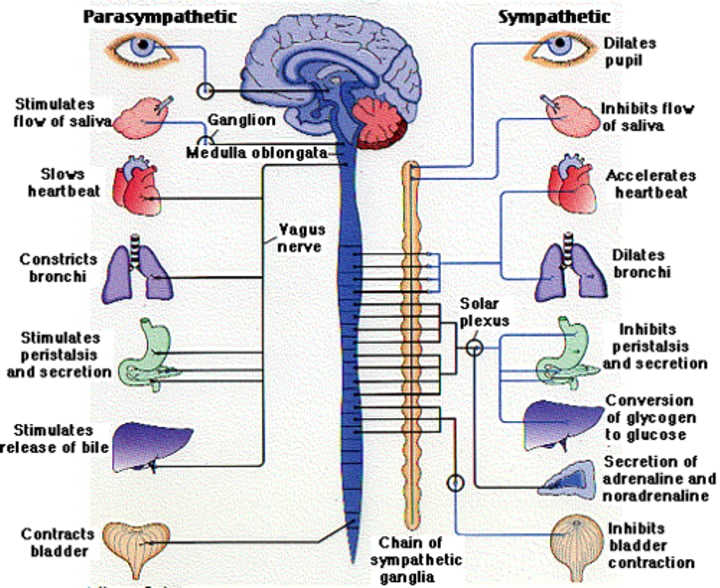
What are cells within the nervous system called?
neurons (or nerve cells)
Labelled diagram of a motor neuron
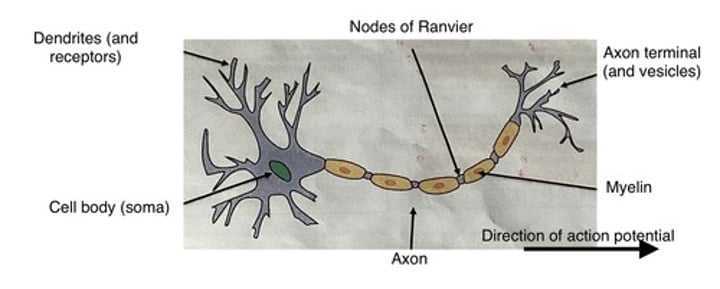
What are dendrites (and receptors)?
Dendrites are the parts of the neuron which receive signals from other neurons. There are receptors on dendrites which are specialised for binding to specific neurotransmitters.
What are Nodes of Ranvier?
Nodes of Ranvier are the small gaps in myelin on the axon. When an electrical signals (action potential) passes along the axon, it 'jumps' from one Node of Ranvier to the next. These gaps in the myelin have the effect of speeding up the action potential.
What is the axon terminal (and vesicles)?
The axon terminal is the end of the axon. There are vesicles in the axon terminal which contain neurotransmitter molecules. When an action potential passes along the axon, it can cause the vesicles to move to the end of the axon terminal and release neurotransmitters into the synapse.
What is the myelin?
The myelin is a fatty substance which protects the axon from damage. It allows signals to pass efficiently along the axon.
What is the cell body (soma)?
The cell body controls all the function of the cell. It contains the DNA. All the incoming signals from other neurons are combined in the cell body in a process called summation.
What is the axon?
The axon transmits electrical signals (action potentials) from the cell body to the axon terminal.
Describe sensory neurons
Sensory neurons transmit sensory information from sense organs (eye, ear, nose, mouth, and skin) to the central nervous system (CNS)
- Sensory neurons are found in the peripheral nervous system.
- Sensory neurons tend to have long dendrites, short axons and a cell body in the middle of the cell.
Describe relay neurons
Relay neurons transmit signals between neurons.
- Relay neurons interpret sensory information.
- Relay neurons are in the central nervous system (CNS).
- Relay neurons have very short axons.
Describe motor neurons
Motor neurons transmit signals from the central nervous system (CNS) to effectors (muscles and glands).
- The signals transmitted by motor neurons cause muscles to move or glands to release hormones into the bloodstream.
- Motor neurons begin in the central nervous system and their axons project into the peripheral nervous system and connect to effectors.
- Motor neurons tend to have shorter dendrites and longer axons (some more than a meter long) than sensory neurons.
Neuron diagrams
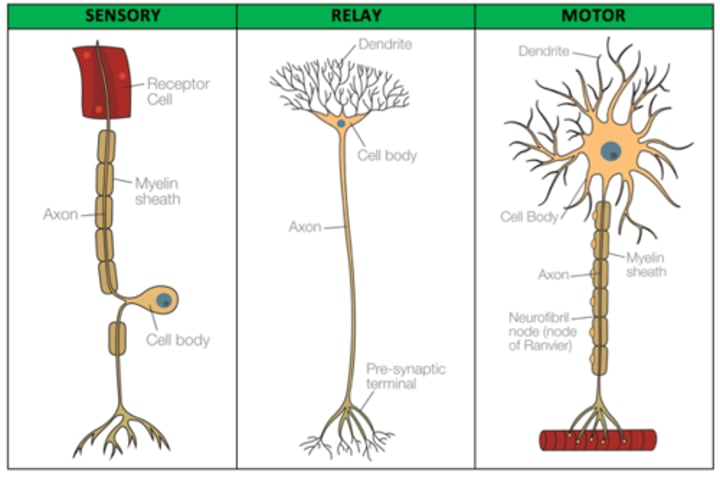
Why do neurons develop connections with many other neurons?
To allow rapid communication of information.
Define synapse
Small gap separating neurons.
Consequence of synapses
The electrical signal that passes along an axon in a neuron (action potential) cannot pass across a synapse to another neuron.
Synaptic transmission
Communication between two neurons must occur through the process of synaptic transmission
What does synaptic transmission involve ?
Neurotransmitters moving from one neuron to another across a synapse.
Effects of neurotransmitters
Different neurotransmitters have different effects; some cause excitation and some cause inhibition.
Excitation
Excitation is when a neurotransmitter causes a neuron to become more likely to have an action potential.
Inhibition
Inhibition is when a neurotransmitter causes a neuron to become less likely to have an action potential.
Example of a neurotransmitter which usually has an excitatory effect
Dopamine
Example of a neurotransmitter which usually has an inhibitory effect
GABA
First stage of synaptic transmission
An action potential passes along the axon in the pre-synaptic neuron.
Second stage of synaptic transmission
This causes vesicles (small containers for neurotransmitters) in the axon terminal of the pre-synaptic neuron to move to the end of the neuron.
Third stage of synaptic transmission
The vesicles then release neurotransmitters into the synapse.
Fourth stage of synaptic transmission
Neurotransmitter molecules move across the synapse and some may bind to receptors on the dendrites of the post-synaptic neuron. (Each neurotransmitter only binds to one type of receptor).
Fifth stage of synaptic transmission
Receptors convert chemical signals from neurotransmitters to electrical signals. These signals are transmitted from the dendrites to the cell body of the post-synaptic neuron and combined with all other incoming signals in a process called summation.
Sixth stage of synaptic transmission
If the overall impact of neurotransmission at a given time is excitatory, the post-synaptic neuron becomes more likely to have an action potential. If the overall impact of neurotransmission at a given time is inhibitory, the post-synaptic neuron becomes less likely to have an action potential.
Process of synaptic transmission
1. An action potential passes along the axon in the pre-synaptic neuron.
2. This causes vesicles (small containers for neurotransmitters) in the axon terminal of the pre-synaptic neuron to move to the end of the neuron.
3. The vesicles then release neurotransmitters into the synapse.
4. Neurotransmitter molecules move across the synapse and some may bind to receptors on the dendrites of the post-synaptic neuron. (Each neurotransmitter only binds to one type of receptor).
5. Receptors convert chemical signals from neurotransmitters to electrical signals. These signals are transmitted from the dendrites to the cell body of the post-synaptic neuron and combined with all other incoming signals in a process called summation.
6. If the overall impact of neurotransmission at a given time is excitatory, the post-synaptic neuron becomes more likely to have an action potential. If the overall impact of neurotransmission at a given time is inhibitory, the post-synaptic neuron becomes less likely to have an action potential.
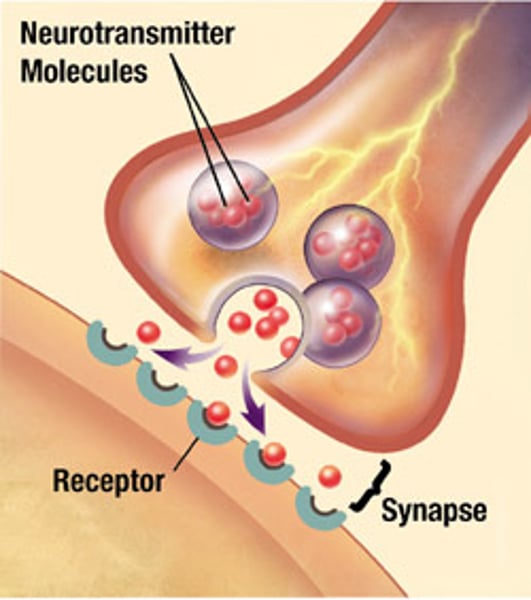
Excitation threshold
Each neuron has a 'threshold'; an amount of excitation that must be reached for an action potential to occur. Action potentials work on an all-or-nothing principle; if the threshold excitation level is exceeded, an action potential occurs, if not it does not. This means an action potential always occurs at the same speed. If there is a large amount of excitatory influence at a given time, this will lead to a high frequency of action potentials in the post-synaptic neuron, but the speed and strength of them does not change.
Define biological rhythms
Bodily processes with repeating cycles over time.
Circadian rhythms
Repeat approximately once every 24 hours.
Infradian rhythms
Repeat less frequently than once every 24 hours.
Ultradian rhythms
Repeat more frequently than once every 24 hours.
Examples of circadian rhythms
The temperature cycle and the sleep-wake cycle
Describe the temperature cycle in terms of circadian rhythms
The temperature cycle in warm-blooded creatures keeps the body at a fairly constant state of warmth. The average temperature of a human body is 37° Celsius. Body temperature ranges from a low of 36.5° at 5am to a high of 37.5° at 5pm.
Examples of infradian rhythms
Menstrual cycle and hibernation
Describe the menstrual cycle in terms of infradian rhythms
The menstrual cycle prepares fertile female mammals for pregnancy. Oestrogen and progesterone are released at various points in the cycle. The average length of a cycle is 28 days in humans.
Describe hibernation in terms of infradian rhythms
Hibernation is a state of inactivity, reduced energy consumption and low body temperature which occurs in some animals including hedgehogs, bears and squirrels. It usually occurs in winter and lasts several weeks.
Examples of ultradian rhythms
Sleep stages and appetite
Describe the sleep cycle in terms of ultradian rhythms
Humans go through 5 stages when sleeping (stages 1, 2, 3, 4 and Ultradian REM). It takes 90 minutes to go through all the five stages before the next cycle of stages begins. We go through 4-5 cycles of the stages of sleep during a night's sleep.
Describe appetite in terms of ultradian rhythms
Appetite is the desire to eat food. This desire fluctuates over the course of the day increasing before consuming food and decreasing after consuming food.
What is the sleep-wake cycle?
The alternation between sleep and wakefulness which repeats daily.
What is the sleep-wake cycle influenced by?
Endogenous pacemakers and exogenous zeitgebers
Define endogenous pacemakers
The parts of the body which control biological rhythms (internal body clocks)
What is the suprachiasmatic nucleus?
The most important endogenous pacemaker for the control of the sleep-wake cycle. The SCN is a group of cells in the hypothalamus of the brain which is sometimes called the body clock. It receives sensory input about sunlight from the eye via the optic nerve and connects to the pineal gland.
Define exogenous zeitgebers
Environmental stimuli which affect biological rhythms.
Which exogenous zeitgeber influences the sleep-wake cycle the most?
Sunlight
Process of detecting sunlight and it's impact on sleep
The sun => Suprachiasmatic nucleus (SCN) => Pineal gland releases less melatonin reducing tiredness
Process of detecting the moon (darkness) and it's impact on sleep
The moon => Dark detected by the retina => Suprachiasmatic nucleus (SCN) => Pineal gland releases more melatonin increasing tiredness
How do pacemakers and zeitgebers interact?
Pacemakers and zeitgebers usually work together to keep the sleep-wake cycle to a regular 24-hour circadian rhythm.
How have some researchers investigated whether pacemakers or zeitgebers are more important for controlling the sleep-wake cycle?
They have looked at whether the sleep-wake cycle remains regular in an organism with no exposure to zeitgebers or without functioning pacemakers.
What did Siffre do?
In 1972 he spent six months living in a tent in a cave in Texas with no natural light and no clocks.

Did Siffre have any light?
Siffre could telephone a research team outside the cave to turn an artificial light in the tent on when he awoke and off when he wanted to sleep.